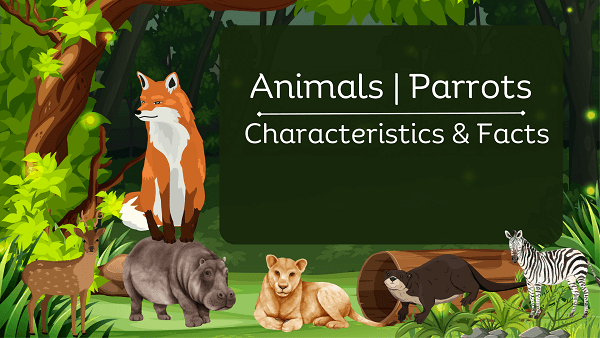Parrots Definition | Characteristics & Facts
Home » Animals » Parrots Definition | Characteristics & Facts
Parrots Definition
Parrots have strong curved bills, an upright stance, and strong grasping feet with four toes, two facing forward and two facing backward. This foot structure allows them to hold and manipulate objects with precision.
General Characteristics & Facts
Sure! Here are some general characteristics and interesting facts about parrots:
Physical Characteristics
Parrots are medium to large-sized birds with a strong, curved beak, a short neck, and a broad, rounded head. They have bright and vibrant plumage, often featuring a wide range of colors. Their wings are adapted for powerful flight, and their zygodactyl feet (two toes facing forward and two facing backward) allow them to climb and grasp objects with dexterity.
Intelligence
Parrots are highly intelligent birds and are considered among the most intelligent animals in the world. They have advanced problem-solving abilities, excellent memory, and impressive learning skills. Their capacity to mimic sounds and speech is a testament to their cognitive capabilities.
Vocal Mimicry
One of the most well-known traits of parrots is their ability to mimic human speech and various sounds from their environment.
Social Nature
Parrots are social birds and often form strong bonds with their flock members or human caretakers.
Diet
Parrots are primarily herbivores, with their diet consisting of fruits, seeds, nuts, berries, and vegetation. Some species also consume flowers and nectar.
Geographic Distribution
Parrots are found in a wide range of habitats, including tropical and subtropical forests, savannas, grasslands, and coastal regions. They are native to Australia, South America, Central America, Africa, and some parts of Asia.
Lifespan
Parrots generally have long lifespans, often living between 20 to 80 years or even more, depending on the species and proper care.
Monogamous Pairing
Many parrot species are monogamous, forming strong pair bonds with a mate that can last for life.
Playful Behavior
Parrots are known for their playful and curious nature. They enjoy interacting with toys, puzzles, and objects, which helps keep their minds stimulated.
Endangered Status
Several parrot species are considered endangered or threatened due to habitat loss, illegal pet trade, and other human-related activities. Conservation efforts are crucial to protecting these species and their ecosystems.
Read our Animals Encyclopedia with Complete Facts
Physical Characteristics Parrots
Beak: Parrots have a strong, hooked beak that is designed for cracking open nuts and seeds, as well as for eating fruits and other plant materials. The beak is one of their most essential tools for feeding and manipulating objects.
Plumage: Parrots are known for their colorful and vibrant feathers. Their plumage can display a wide range of colors, including red, green, blue, yellow, orange, and more.
Wings: Parrots have large, powerful wings that enable them to fly skillfully. Their ability to fly efficiently allows them to cover long distances and navigate through various habitats.
Tail: Parrots typically have a long, strong tail that helps with balance and maneuvering during flight. Some species have distinctive tail shapes or patterns.
Feet: Parrots have zygodactyl feet, meaning they have four toes on each foot, with two toes facing forward and two facing backward.
Size: They can range from small species like budgerigars (parakeets) that are around 6 inches (15 cm) in length to large species like macaws, which can reach up to 3 feet (90 cm) in length.
Head Shape: Parrots have a distinctive rounded head with a short neck, giving them an adorable and recognizable appearance.
Cere: The core is the area just above the beak where the nostrils are located. The color and texture of the cere can vary between male and female parrots and can be used to determine their gender in certain species.
Eye Rings: Some parrot species have distinct eye rings or eye patches, which can add to their unique and charming look.
Sexual Dimorphism: In many parrot species, males and females have slight differences in physical appearance, such as coloration or size, known as sexual dimorphism.
Continue To Explore All Animals That Start With P
Scientific Classification of Parrots
Subfamily: Psittacinae
Subfamily: Arinae
Key Locations
- Australia
- South America
- Central America
- Africa
- Southeast Asia
- New Zealand
- Pacific Islands
- Caribbean Islands
- India
- New Caledonia
View All A-Z Animals List
FAQs Parrots
What do Parrots eat?
- Fruits
- Seeds
- Nuts
- Vegetables
- Pellets
- Grains
- Legumes
- Nectar
- Flowers
- Berries
Explore More:
- Tarantula
- Mackerel
- Mackerel
- Sea Stars
- Bird
- Amphibians
- Vertebrates
- Sand Dollars
- Barnacles
- Scallop
- Brittle stars
- Tilapia
- Carp
- Krill
- Catfish
- Grouper
- Calm
- Yak
- Yucatan Brown Brocket
- White-tailed Deer
- Uakari
- Utahraptor (Dinosaur)
- Qinghai Lake Naked Carp
- Qilian Shrew
- Qinling Panda
- Qacha’s Nek long-fingered Frog
- Red Fox
- Red Panda
- Rockhopper Penguin
- Salamander
- Snail
- Storks
- Jacana
- Junglefowl
- Jabiru Stork
- Junco
- Japanese Crane
- Kudu
- Kingfisher
- Giant Stuffed Tiger
- Giant Stuffed Dolphin
- Giant Stuffed Bear
- Giant Stuffed Penguin
- Scrat (Ice Age)
- Freshwater Clams
- Water snakes
- Sphynx at
- Honeybees
- Parrots
- Caribou (also known as reindeer)
- Nemo (from Finding Nemo)
- Simba (from The Lion King)
- Pink Panther
- Garfield


